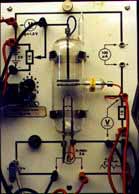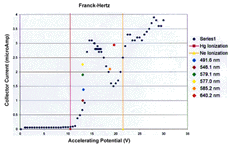
Electrons are accelerated through a thin gas of Neon and Mercury from a hot filament towards a collection electrode. As the current applied to the filament is increased, the electron velocities increase, increasing the current across the gas potential barrier. However, the electrons suffer energy loss via collisions with the Neon and Mercury gas molecules. The object is to adjust the filament current so that the electrons cause collisional excitation of the gas molecules. This is observed by the subsequent deexcitation, and spectral line emissin of the gas molecules. As a result of these collisions, the accelerated electrons are unable to reach the collection electrode and the current across the barrier drops sharply.
At left is the Franck-Hertz apparatus. The tube is filled with a thin gas of Neon and Mercury. The filament at the bottom is used to accelerate electrons towards the collection electrode near the center of the tube. As the electron energies begin to collisionally excite Neon, a faint purple glow appears near the collection electrode.



